To Start the Discussion
I'll write up a few things from memory. Since your input is limited to \$30\:\mu\text{A}\$ and since I never start with that limitation but instead work out what I need to supply as an output, not as an input to the design, what I have to say will have to be considered with that in mind.
Also, I'm keeping in mind that this is a boost application. So it must be the case that \$V_{_\text{IN}}\lt V_{_\text{OUT}}\$.
Let's say that my semiconductor switching device, when on, drops \$V_{_{\text{Q}_\text{ DROP}}}=100\:\text{mV}\$ and my semiconductor flyback diode drops \$V_{_{\text{D}_\text{ FLY}}}=300\:\text{mV}\$. (I'm just picking this out of thin air, for now, to simply establish that there are some realities that have to be accepted and dealt with.) Then the applied voltage across the inductor during the on period is \$V_{_{\text{ON}}}=V_{_\text{IN}}-V_{_{\text{Q}_\text{ DROP}}}\$ and the inductor's flyback voltage during the off period is \$V_{_{\text{OFF}}}=V_{_\text{OUT}}+V_{_{\text{D}_\text{ FLY}}}-V_{_\text{IN}}\$. (I'm assuming a little something about the topology there. Hopefully, this comports with your case.) The duty cycle is then \$D=\frac{V_{_{\text{OFF}}}}{V_{_{\text{ON}}}+V_{_{\text{OFF}}}}\$ and the peak inductor current needs to be \$I_{_{\text{PEAK}}}=2 I_{_{\text{OUT}}}\frac1{1-D}\$.
Since you are specifying \$30\:\mu\text{A}\$ as an input limitation, I take this to mean that \$I_{_{\text{PEAK}}}=30\:\mu\text{A}\$ as an input to the design. So this means that \$I_{_{\text{OUT}}}=\frac12\left(1-D\right)I_{_{\text{PEAK}}}\$. That's going to be your first moment of validation as to whether or not you can achieve what you want to achieve, at all. If the output current doesn't meet your requirement, you are done. You cannot do what you want to do with what you have. Box the idea up and put it on a shelf. Game over.
Note that frequency and Joules haven't even entered into the above. The frequency will be proportional to the inductance, \$L\$, the peak inductor current, \$I_{_{\text{PEAK}}}\$, and inversely proportional to a concept that kind of looks like taking \$V_{_{\text{ON}}}\$ and \$V_{_{\text{OFF}}}\$ in parallel, \$\frac{V_{_{\text{ON}}}\cdot V_{_{\text{OFF}}}}{V_{_{\text{ON}}}+V_{_{\text{OFF}}}}\$. Obviously, of the above, you are missing \$L\$. So we can't speak of frequency, just yet. The inductor needs to be designed. That's the entire point, here. And now, without frequency, there's no point in talking about Joules, either.
You need to fill out the details, now. If you do, I may expand this into a real answer. For now, it's here to get you to improve the question. It was more than I could consider writing as comments.
Playing With Your Added Details
- \$V_{_\text{IN}}=1.6\:\text{V}\$
- \$V_{_\text{OUT}}=5\:\text{V}\$
- \$I_{_\text{IN}}=30\:\mu\text{A}\$
I've no idea what your practical switch and diode are, but I'm going to stick with the numbers I started with:
- \$V_{_{\text{Q}_\text{ DROP}}}=100\:\text{mV}\$
- \$V_{_{\text{D}_\text{ FLY}}}=300\:\text{mV}\$
From here I find:
- \$V_{_{\text{ON}}}=1.6\:\text{V}-100\:\text{mV}=1.5\:\text{V}\$
- \$V_{_{\text{OFF}}}=5\:\text{V}+300\:\text{mV}-1.6\:\text{V}=3.7\:\text{V}\$
- \$D=\frac{3.7\:\text{V}}{1.5\:\text{V}+3.7\:\text{V}}\approx 0.712\$
Now, let's add in another specification you gave:
- \$I_{_\text{OUT}}=10\:\text{mA}\$
From this, I find:
- \$I_{_\text{PEAK}}=2\cdot 10\:\text{mA}\cdot\frac1{1-0.712}\approx 70\:\text{mA}\$
Note that this is quite a bit more than \$30\:\mu\text{A}\$.
Now, if you plan to use this output supply only for very short periods of time and can spend a lot of time, beforehand, charging up an output capacitor, then perhaps there's more to discuss. In this case, we can say:
- \$I_{_\text{OUT}}=\frac12\cdot 30\:\mu\text{A}\cdot\left(1-0.712\right)\approx 4.3\:\mu\text{A}\$
And you may use that to help charge up a capacitor for occasional use.
Unfortunately, some of the earlier assumptions made in developing those earlier relationships I wrote above (an equilibrium state, which is no longer true) also no longer apply in the same way as before. Which means developing new equations for this specific purpose, if so.
I'll leave it there, for now.
